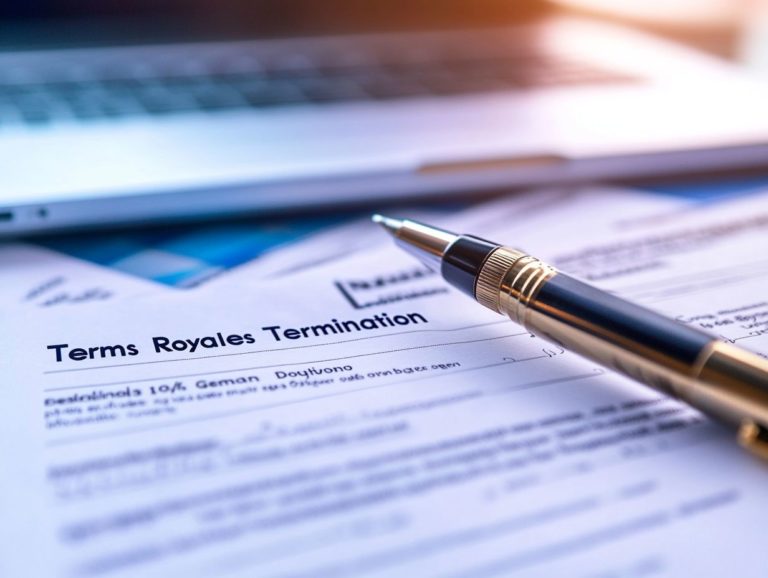Understanding Royalties in Licensing Agreements
Licensing agreements are important tools across various industries, granting you the rights to use creative works while clearly defining the financial terms involved.
At the core of these agreements is the concept of royalties, which act as compensation for the rights you receive. This article delves into the different types of royalties fixed, percentage, and minimum guarantees and examines the factors that influence royalty rates, including industry standards and market demand.
Whether you re a creator or a business entity, grasping these elements is essential for effective negotiation and maximizing the value you derive from licensing agreements.
Contents
- Key Takeaways:
- Royalties in Licensing Agreements
- Types of Royalties
- Factors Affecting Royalty Rates
- Negotiating Royalties in Licensing Agreements
- Frequently Asked Questions
- What are royalties in licensing agreements?
- How are royalties calculated in a licensing agreement?
- What types of IP can be subject to royalties in a licensing agreement?
- Are there different types of royalty structures in licensing agreements?
- Can royalties be paid upfront in a licensing agreement?
- How important is it to clearly define royalties in a licensing agreement?
Key Takeaways:

Royalties are payments made to you for using someone else’s creative works in a licensing agreement. They serve as a way for licensors to earn income from their rights.
There are three main types of royalties: fixed, percentage, and minimum guarantees. Each has its own advantages and disadvantages, and the type chosen will depend on factors such as industry standards and the value of the creative work.
When negotiating royalties in a licensing agreement, consider factors such as industry standards, market demand, and effective negotiation strategies. Both parties should aim for a fair and mutually beneficial agreement to ensure the success of the licensing arrangement.
What is a Licensing Agreement?
A licensing agreement is a legally binding contract that allows you as the licensee to use specific creative works, thanks to the generosity of the licensor. This agreement lays out the terms and conditions clearly, detailing everything from the scope of use to payment terms and the responsibilities of both parties.
It s essential to ensure compliance with the laws governing creative work rights. These agreements are vital across industries, as they not only facilitate revenue sharing but also protect the interests of all involved while adhering to contract law principles.
In the tech world, these agreements might cover software, patents, or trademarks, giving you the freedom to innovate without stepping on anyone’s toes. In entertainment, they dictate the use of films, music, or graphic designs, allowing creators like you to monetize your work while granting others permission to use it. In publishing, licensing is key to distributing books and digital content, helping you reach a broader audience.
The roles of both the licensor and licensee are crucial; while the licensor must protect their rights, you as the licensee gain access to valuable assets. Clear terms and defined jurisdiction are critical in crafting effective licensing agreements, ensuring that you fully understand your rights and responsibilities.
Royalties in Licensing Agreements
Royalties are your financial reward in licensing agreements, acting as the compensation you provide to the licensor for the privilege of utilizing their creative works.
These payments can take several forms, such as fixed royalties, percentage royalties, or minimum guarantees, each tailored to reflect the asset’s value and the market’s appetite.
By clearly defining payment terms and royalty rates, you can foster a mutually beneficial financial arrangement, reducing the risk of compliance issues and potential disputes along the way.
Definition and Purpose of Royalties
Royalties are your compensation payments for the use of creative works, allowing others to leverage your assets while ensuring that revenue is shared fairly based on agreed-upon financial arrangements. These payments not only incentivize the creation and distribution of creative works like music, books, and patents but also provide you, the licensor, with financial returns while granting the licensee access to valuable resources.
In the realm of licensing agreements, royalties establish a symbiotic relationship that enables both parties to flourish. For you as the licensor, these payments create a steady income stream vital for funding your future creative projects. Meanwhile, the licensee benefits from using your property without the weight of ownership responsibilities. Understanding the financial aspects of licensing agreements can further enhance this mutually beneficial arrangement.
Take the music industry as an example: performance royalties are collected every time your song is played publicly, ensuring you receive compensation for your artistry. Similarly, authors earn royalties for each book sold, generating ongoing revenue over time. Such arrangements motivate creators like you and profoundly influence creative industries, promoting innovation and collaboration.
Types of Royalties
Licensing agreements can include different types of royalties. Each type serves different needs and market conditions.
Fixed royalties provide a set amount, giving both parties financial security.
In contrast, percentage royalties vary with sales, ensuring that your interests align with the licensee’s success.
Minimum guarantees create a safety net, ensuring you receive a set amount regardless of the licensee’s performance. This is especially appealing for licensors seeking financial stability.
Fixed Royalties

With fixed royalties, you agree to pay a set amount to the person or company giving the license, no matter how well the product does. This offers both of you financial security and is great for stable markets.
This model is especially effective for long-lasting products or when the licensor has a strong brand. It reduces the financial risks from sales fluctuations, ensuring a steady income.
As a licensee, this setup simplifies budgeting and lets you allocate resources more effectively. This also fosters a collaborative relationship between you and the licensor.
With fixed royalties, you can focus on maximizing sales without worrying about variable royalty payments. This can enhance overall business performance and provide stability for new ventures or established companies.
Percentage Royalties
Percentage royalties involve you paying the person or company giving the license a specific percentage of the revenue generated from the licensed product. This directly links the product’s success to your royalty payments.
It’s a win-win, aligning both parties’ incentives and encouraging you to maximize sales while ensuring the licensor benefits from your success.
These agreements usually have clear terms, including:
- Percentage rate
- Applicable deductions
- Payment schedules
This clarity protects both parties’ interests and fosters transparency.
Market conditions greatly influence royalty rates, with factors like competition, demand, and existing licensing relationships playing key roles.
Consider case studies from the entertainment industry. They show how effective revenue-sharing models can elevate brands, highlighting the benefits of well-structured agreements.
Minimum Guarantees
Minimum guarantees serve as a financial safety net in licensing agreements. They ensure you, as the licensor, receive a specified minimum amount in royalty payments, regardless of the licensee’s sales performance.
This setup not only protects your income but also motivates the licensee to aim higher. Minimum guarantees are crucial in industries like entertainment, publishing, and merchandise, where sales uncertainty can be significant.
By establishing this baseline payment, you can better forecast your revenue and maintain financial stability, even if the licensee’s product doesn’t perform well.
For licensees, this structure can drive motivation to market the product effectively, as exceeding the minimum can unlock extra earnings. However, it can also create pressure to achieve quick sales.
In sectors like fashion and technology, minimum guarantees are widely used, ensuring fair compensation for creative talents and brand owners while allowing licensees the freedom to innovate.
Factors Affecting Royalty Rates
Many factors shape royalty rates in licensing agreements. This creates a complex situation that requires careful navigation to establish fair compensation structures.
Market demand is vital; when interest in specific intellectual property rises, it often justifies higher royalty rates. Industry standards provide benchmarks that help calculate royalties, while the perceived value of intellectual property can greatly influence negotiations.
Industry Standards
Industry standards are crucial for determining royalty rates. They offer the guidelines needed to establish fair compensation based on market data.
These standards vary across sectors, reflecting the unique challenges and opportunities in each industry. For instance, the music industry often sees royalty rates influenced by streaming trends, while pharmaceutical companies focus on innovation and R&D costs.
Understanding these benchmarks is essential for effective negotiation and compliance with legal standards. Following established norms can reduce the risk of disputes, fostering trust and paving the way for long-term partnerships based on fairness.
Market Demand and Competition

Market demand and competition significantly influence royalty rates in licensing agreements. High demand for specific intellectual property usually leads to increased royalty rates.
If competition among licensees grows, licensors may negotiate better terms to maximize returns. In fast-moving industries like technology and entertainment, shifts in consumer preferences can greatly impact licensing deals.
For example, the rise of streaming services has transformed royalty agreements in the music industry. Artists and producers need to adapt to these new revenue models.
As demand changes, licensors might ask for higher rates, while licensees could seek exclusive agreements to control costs. Conducting thorough market research and building strong relationships can enhance negotiating power for both parties.
Intellectual Property Value
The perceived value of intellectual property is key in setting royalty rates. A higher perceived value often leads to higher compensation.
You have several ways to assess this value, including income-based valuation, market comparisons, and cost-based methods. Each approach offers different insights for developing appropriate royalty structures.
Understanding these methods equips you for negotiations and helps you substantiate your position. For instance, a leading tech company used income-based valuation to negotiate significantly higher royalties for its patented technology.
Meanwhile, a creative firm successfully justified its licensing fees using competitor data. These examples illustrate how the right valuation approach can influence final agreements.
Negotiating Royalties in Licensing Agreements
Negotiating royalties in licensing agreements requires careful attention to factors like industry standards, market demand, and the unique value of intellectual property. Mastering effective negotiations can lead to outcomes that benefit both licensors and licensees.
By understanding how to navigate this complex landscape, you can secure favorable terms and achieve lasting success in your agreements.
Important Considerations
When you’re negotiating royalties, it’s crucial to consider several important factors. Ensure that both you and the other party come away with a favorable licensing agreement.
Understanding the legal frameworks that govern creations like inventions, designs, or brands, identifying any compliance issues, and being aware of industry standards are all critical elements. These can significantly influence the negotiation process and the final terms.
It’s essential for you, whether you’re a licensor or a licensee, to conduct thorough market research to understand current trends. This knowledge will give you leverage in discussions and clarify industry expectations.
Meticulous preparation is key; gather detailed documentation that outlines your expectations, previous license agreements, and financial forecasts.
Open communication is vital. Establishing trust can lead to smoother exchanges and ultimately result in an agreement that satisfies both parties.
Being ready to adapt and negotiate terms based on feedback will also help you navigate any potential roadblocks that may arise throughout the process.
Effective Negotiation Strategies
Employing effective negotiation strategies is essential for securing favorable royalty payments in licensing agreements. This can significantly influence the overall success of your partnership with licensors or licensees.
Key strategies include thorough preparation, establishing clear objectives, and fostering open communication. This approach helps tackle any potential disputes before they escalate.
Building rapport is crucial; it cultivates trust and facilitates smoother discussions. For instance, using market data to showcase the potential value of a licensing deal strengthens your negotiating position and helps both parties appreciate the shared benefits.
Consensus-building techniques can further alleviate tensions. They encourage collaborative problem-solving that leads to innovative solutions satisfying both sides.
A memorable example involves a recent agreement where open dialogue allowed one party to tailor their offer. This resulted in a mutually beneficial outcome while preemptively addressing concerns that could have sparked disputes.
Frequently Asked Questions

What are royalties in licensing agreements?
Royalties are a percentage of revenue or profit that a licensee pays to a licensor for the use of their intellectual property in a licensing agreement.
How are royalties calculated in a licensing agreement?
Royalties are typically calculated based on a percentage of the licensee’s revenue or profit from the use of the licensed intellectual property. The specific percentage is negotiated between the licensor and licensee and included in the trademark licensing agreements.
What types of IP can be subject to royalties in a licensing agreement?
Any type of intellectual property, such as patents, trademarks, copyrights, or trade secrets, can be subject to royalties in a licensing agreement.
Are there different types of royalty structures in licensing agreements?
Yes, various types of royalty structures can be used in licensing agreements, such as fixed, tiered, or hybrid royalties. The structure is determined by the terms negotiated between the licensor and licensee.
Can royalties be paid upfront in a licensing agreement?
Yes, sometimes a one-time upfront payment, also known as an advance, can be included in the royalty structure in a licensing agreement. This is typically negotiated between the parties and can be beneficial for both the licensor and licensee.
How important is it to clearly define royalties in a licensing agreement?
Both the licensor and licensee must clearly define the terms and conditions of royalties in a licensing agreement. This helps avoid any confusion or disputes in the future and ensures fair compensation for the use of the licensed intellectual property. It is recommended to seek legal advice when negotiating and drafting a licensing agreement to ensure all terms, including royalties, are clearly defined.





